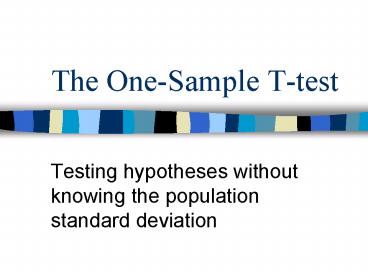The OneSample Ttest
1 / 9
Title: The OneSample Ttest
1
The One-Sample T-test
- Testing hypotheses without knowing the population
standard deviation
2
The Basics
- Z-test formula
- (Sample mean null mean)/(pop.stand.dev./sqr.
Root N) - What if we dont know pop.stand.dev.?
- We have to use our sample standard deviation to
estimate the pop.stand.dev.
3
Estimating
- Pop standard deviation sqr.root(SS/n)
- Estimate of pop.stand.dev sqr.root(SS/n-1)
- N-1 degrees of freedom
4
Degrees of Freedom
- The number of independent pieces of information a
sample of observations can provide for purpose of
statistical inference. - If the mean of a sample is 10 and has 3 numbers
in the sample, how many are independent (free to
vary)? - First number is 110, second number is 85, what
is the third number? - 110-85530/103
- If we know the mean, only n-1 numbers can vary
freely.
5
Degrees of Freedom, cont.
- When estimating standard deviations, the numbers
are bound by the fact that the sum of the
deviations from the mean must 0 - Thus, only n-1 numbers are free to vary.
- Degrees of freedom n-1
6
How do we use degrees of freedom?
- Estimating standard deviation
- Finding critical values for our hypothesis test.
- Finding the t-values that cut off an appropriate
5 of the distribution. - The critical values define the critical region
- If our OBSERVED t falls in the critical region,
the probability associated with OBSERVED t must
be lt .05 - Practice table on page 357-359
- Critical values for two-tailed .05, n 20
- One-tailed .01, n 10
- One-tailed .05, n 15
7
Students t-distribution
- Similar to z (normal) and identical when n is
large. - When n is small, t is heavier in the tails,
narrower in the shoulders. - Is slightly different for each degree of freedom
8
Doing a t-test
- State null and alternative
- Is alternative directional or not?
- Decide on alpha, identify critical values
- t (sample mean null mean)/estimate of
pop.stand.dev/sqr.root(n) - Cant compute the exact probability of observed
t, so, we ask the question Does t fall in
critical region(s)?
9
Confidence intervals
- The same as previously, except
- Use standard error derived from estimate of
pop.stand.dev. - Use critical value identified in t-distribution
using degrees of freedom. - Formula sample mean - tcrit(stand.error)































